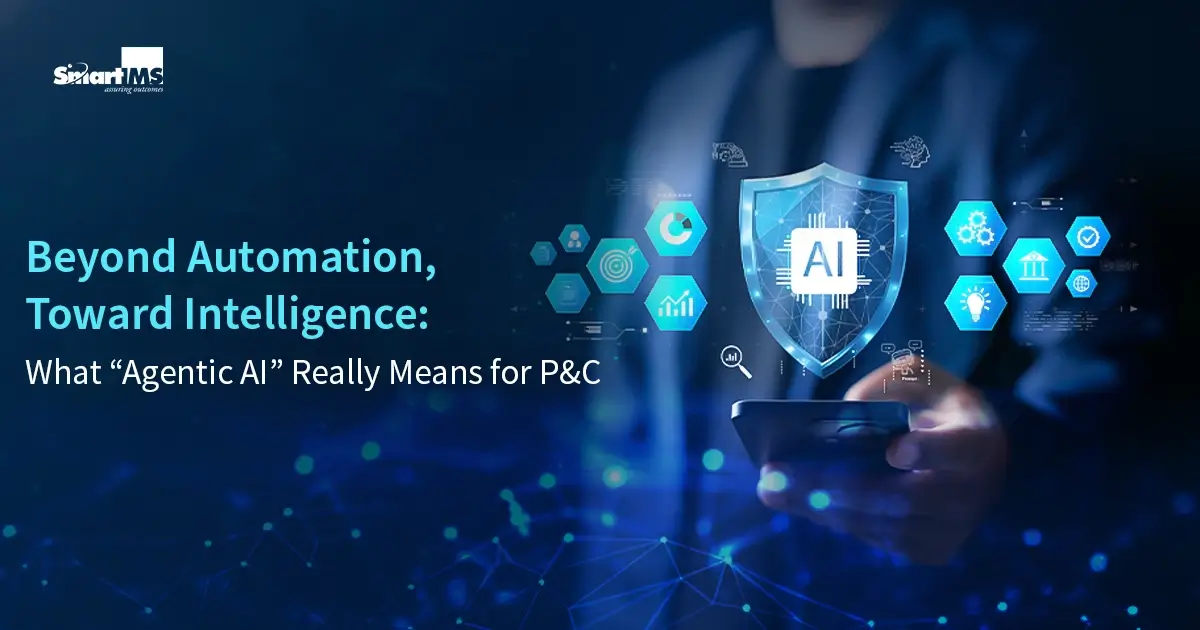RPA and point “intake automation” have hit diminishing returns. The next efficiency and experience gains in P&C will come from Agentic AI, systems that can understand, reason, and take actions through your tools and data under guardrails. Start with 5–7 high-leverage assistant patterns (triage, options generation, coverage Q&A with citations, FNOL helper, claims pack builder) and design them as Natural Language Experiences (NLX), voice or chat, embedded into underwriting, claims, and policy workflows. Success looks like fewer handoffs, higher straight-through rates, and answers with sources, not “chat.”
Let’s understand it in detail.
Why “More Intake Automation” Isn’t Moving the Needle Anymore?
Most carriers have already automated the obvious: screen scraping, simple forms, basic OCR. Those helped, but three realities persist:
- Work is still cognitive. Underwriters and claims professionals make judgment calls across messy, unstructured inputs (emails, PDFs, images, notes).
- Edges are everywhere. If your rules don’t see a field, the process stops and people re-key or chase clarifications.
- Users want answers, not tasks. A producer doesn’t want a form; they want “Are we in appetite? If yes, what options and what’s missing?”
Automation handles “known paths.” P&C is full of “it depends.” We need systems that can interpret, decide, and act, and tell us why.
Now, let’s take a look at,
What Agentic AI is? (and is not)
Agentic AI combines three skills:
- Perceive: Read emails, ACORDs, loss runs, invoices, photos, and policy PDFs.
- Reason: Apply appetite, guidelines, and state rules to form an opinion with uncertainty quantified.
- Act: Call tools and APIs (policy lookup, rating, document generation, notes creation), draft communications, and route packets, under auditable guardrails.
Not a chatbot glued to a knowledge base. The difference is tool use and guard railed action: the assistant doesn’t just say “You might be eligible”; it checks, fills, posts, and cites.
Okay now that we read what agentic AI is (and not), let’s go through NLX.
NLX: The New Front Door
Think of Natural Language Experiences (NLX), voice or chat, as the front door to work:
- Underwriting inbox assistant: “Summarize the submission, check clearance, compare SOV vs appetite, and list missing items, then create activities for each.”
- FNOL helper: “Guide caller through a workers’ comp FROI, validate jurisdiction, and pre-create a clean claim setup.”
- Coverage Q&A: “What’s the water damage sublimit on Policy X?” → precise clause-level answer with effective dates and source citations.
What good looks like:
- Answer with source (policy clause, endorsement, note, or rule).
- Low friction (single turn for simple asks, brief follow-ups when required).
- Latency you can live with (sub-5s for lookups; sub-15s for heavy packets).
- Action, not prose (tickets created, letters drafted, data posted).
Five Concrete Patterns (You Can Pilot This Quarter)
1) Submission Concierge & Appetite Triage
- Where: Small Commercial & Specialty UW desks.
- What it does: Parses broker email + attachments (ACORD 125/126/140, SOV, loss runs), normalizes key fields, checks clearance/appetite, and produces a clean submission packet.
- Outcome: 20–30 minutes saved per submission; fewer back-and-forths with brokers; clearer decline/redirects.
2) Quote Options Generator
- Where: New business quoting.
- What it does: Drafts 2–3 defensible option sets (limits/deductibles/terms) inside your guardrails; calls your rating microservices where available; flags where an underwriter must approve.
- Outcome: Faster first-pass quotes; consistent guardrails; better producer experience.
3) Coverage Q&A with Clause-Level Citation
- Where: UW, CSR, and agent support.
- What it does: Answers “What’s covered?” with the exact clause and date; cites policy, endorsements, or filings; logs the question/answer.
- Outcome: Lower escalation volume; fewer interpretive errors; traceability for audits.
4) FNOL Helper (voice/web)
- Where: Claims intake.
- What it does: Conversationally guides callers through intake; validates fields (no full SSN readback, safe handling of PII), pre-fills from policy, and emits a validated FNOL to claim setup.
- Outcome: Cleaner first-time data; shorter call times; less rework for adjusters.
5) Claims Pack Builder & Timeline
- Where: Complex claims or litigation prep.
- What it does: Extracts events from notes/emails/PDFs, lines them up chronologically, finds missing documents, and drafts a focused “what happened” with citations.
- Outcome: Faster file reviews; better handoffs; stronger EUO/negotiation prep.
(You can add Premium Audit Assistant in Workers’ Comp, Estimate Variance Checker in property, and Subrogation Opportunity Finder in auto/property—all built on the same pattern: perceive → reason → act.)
Simple Stories from the Floor
- Small Commercial UW desk: An assistant triages 60 incoming submissions/day. It classifies, extracts top 20 fields, checks appetite, and creates three activities per submission (clearance, missing info, rating check). The underwriter starts work with a ready packet, not a messy inbox.
- WC FNOL line: A caller starts with voice; the assistant collects only required data, confirms the last 4 of SSN safely, and posts a structured intake. The adjuster opens a claim with fewer follow-ups and a clear initial summary.
- CSR coverage line: “Is water backup covered at 123 Main St. policy?” The assistant cites the endorsement, clarifies limits, and drafts a customer-safe explanation. The CSR just reviews and sends.
What Trips Carriers Up?
- Pilot purgatory. Demos look great; nothing gets to production because no tool access or no data stewardship.
- Chat instead of action. A pretty UI that doesn’t create activities, letters, or transactions is just another FAQ.
- Uncited answers. If it can’t point to a clause or rule, your users won’t trust it.
- No guardrails. Free-form writing to customers without templates/phrases/approvals is a governance issue waiting to happen.
- Latency blindness. If the assistant takes 25 seconds to answer, users will abandon it.
- “One big model” thinking. Use the right combination: retrieval, small adapters, and a few smart tools—not a magic brain.
What “Ready” Looks Like (Checklist)?
- Data: Policies, endorsements, rules, and notes searchable and citable.
- APIs/Tools: Basic tool layer, policy lookup, rating proxy, document generation, notes/tasks creation.
- Guardrails: Templates, phrasing library, approval thresholds, and audit logs.
- NLX channel: Chat widget or voice line embedded in the apps users already live in.
- Metrics: Task time, straight-through %, answer correctness (with human review), escalation rate, latency.
Quick ROI Math (Back-of-the-envelope)
- Submission concierge: Save 18 minutes per submission × 50/day × 220 days ≈ 3,300 hours/year for one desk. Even at $70/hour fully loaded, that’s >$230K/year—before you count faster cycle times and hit rates.
- Coverage Q&A: If you reduce escalations by 30% for a 10-person CSR team, that’s hundreds of hours/year and fewer E&O risks thanks to citations.
- FNOL helper: Cut re-work and reduces average handle time; even 10–15% reduction on a high-volume line makes the business case.
Where To Start (And What To Skip)?
Start:
- 1–2 assistants in underwriting/claims where data and tools already exist.
- Build citation first and action second (create tasks/letters/transactions).
- Measure, publish the before/after, then expand.
Skip (for now):
- “AI everywhere” roadmaps.
- Anything without tools access or citation.
- New channels your users won’t adopt (keep it where they work).
The Mindset Shift
Agentic AI changes the unit of work from screens and clicks to goals and outcomes. When a user says, “Draft options and email the broker,” the assistant perceives, reasons, acts, and shows its work. That is the leap “beyond automation.”
If you’re at ITC Vegas event 2025, connect with Smart IMS and let’s compare notes on which 5 patterns you’ll run first, and how to make them production-ready in 90 days.




